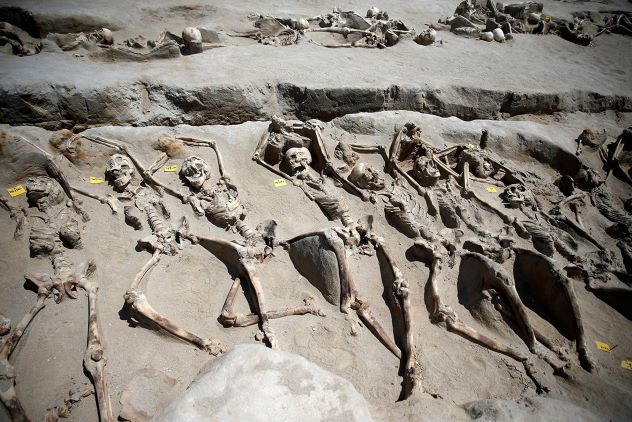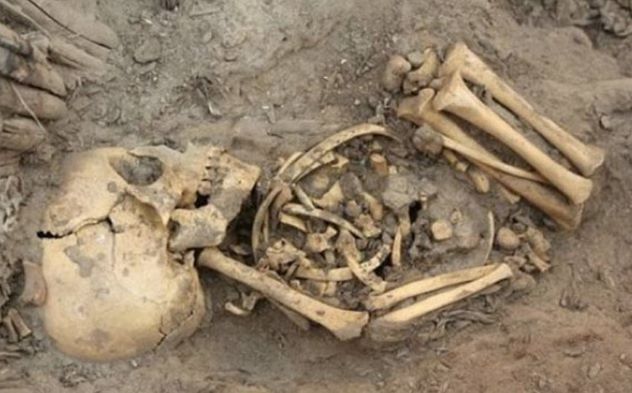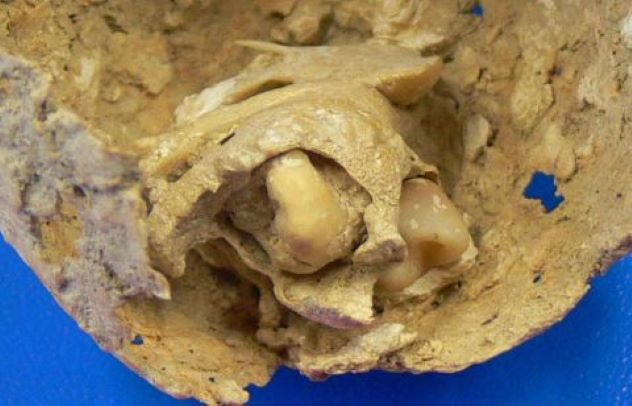 Mysteries
Mysteries  Mysteries
Mysteries  History
History 10 Surprising Stories About the Texas Rangers
 Humans
Humans 10 Philosophers Who Were Driven Mad by Their Own Theories
 Miscellaneous
Miscellaneous 10 Video-Game-Worthy Weapons and Armors from History
 Weird Stuff
Weird Stuff 10 Psychics Who Accurately Predicted Wartime Events
 The Arts
The Arts 10 Pieces of Art Inspired by a Broken Heart
 Health
Health 10 Science Fiction-Sounding New Medical Treatments
 History
History 10 Surprising Facts About the Father of Submarine Warfare
 Space
Space Ten Astonishing New Insights into Alien Worlds
 Weird Stuff
Weird Stuff 10 Bizarre Summer Solstice Rituals Still Practiced Today
 Mysteries
Mysteries Top 10 Haunting Facts About the Ghost Ship MV Alta
 History
History 10 Surprising Stories About the Texas Rangers
 Humans
Humans 10 Philosophers Who Were Driven Mad by Their Own Theories
Who's Behind Listverse?

Jamie Frater
Head Editor
Jamie founded Listverse due to an insatiable desire to share fascinating, obscure, and bizarre facts. He has been a guest speaker on numerous national radio and television stations and is a five time published author.
More About Us Miscellaneous
Miscellaneous 10 Video-Game-Worthy Weapons and Armors from History
 Weird Stuff
Weird Stuff 10 Psychics Who Accurately Predicted Wartime Events
 The Arts
The Arts 10 Pieces of Art Inspired by a Broken Heart
 Health
Health 10 Science Fiction-Sounding New Medical Treatments
 History
History 10 Surprising Facts About the Father of Submarine Warfare
 Space
Space Ten Astonishing New Insights into Alien Worlds
 Weird Stuff
Weird Stuff 10 Bizarre Summer Solstice Rituals Still Practiced Today
Top Ten Most Disturbing Burial Sites Discovered
It’s getting pretty close to Halloween, isn’t it? Then (and I whole-heartedly agree with this), it’s the perfect time to sit down and creep yourself out. And what better way to do it than to read about horrible things done in the past to our fellow man.
Here, you will find the stories of some disturbing burial sites from days gone by. There are sites for vampires, witches, gladiators, and one just for heads.
Enjoy your journey six feet under the ground with the buried bones of history!
Related: Top 10 Shocking Shallow Grave Discoveries
10 Mass Grave of Shackled Young Men

The upsetting sight of 80 skeletons, a significant number of them shackled, were uncovered by archeologists in an ancient Greek graveyard called the Falyron Delta Necropolis in 2016. However, what was most disturbing about the corpses was that their jaws were left hanging open, almost as though they were screaming as they were slaughtered.
A great deal of uncertainty surrounds their demise, but one plausible theory for their execution is that the skeletons were once supporters of the Athenian noble Cylon. Cylon endeavored to overthrow the government or the Archons of Athens with his followers in 632 BC but failed wretchedly. Although he got away, verifiable records disclose that every one of Cylon’s supporters was sure to be executed, and these remains seem to give the evidence needed to solidify that theory.
Archaeologists later determined that the bodies had died from blows to the back of their heads. They were also dated back to sometime between 650 and 625 BC. The skeletons were deemed to have died young and healthy before being buried. The way they were buried in an orderly fashion suggests that they were buried with respect, even though they had supposedly revolted against their king. [1]
9 Vampire Burials in Bulgaria
Archeological unearthings have found that Bulgaria is home to about 100 vampire burial sites. In the Balkans during the Middle Ages, vampire superstitions were spread far and wide and were widely feared. On account of these convictions, individuals sometimes took safeguards to protect themselves, even after someone’s death. For the bodies of individuals who endured unusual and disturbing deaths, especially when it was by suicide, certain precautions were taken to ensure that their bodies would remain dead.
In Perperikon, one man in his 40s was found to have an iron pole pounded into his chest to keep him from moving. In addition, his leg had been cut off and placed beside this body to immobilize him. The placement of the iron poles was done by pounding the plowshare into a broken shoulder, popping off one’s collarbone in the process, as was done to this mystery man. However, different skeletons have been found with metal items lodged in their ribcages close to where their hearts ought to be or even through the solar plexus as another method to keep the dead, well, dead.
Of course, the most famous vampire execution was to have a stake pounded through their chest and perhaps a clove of garlic around the gravesite. This method was a superstitious way of restraining the dead from reemerging as a demonic vampire intent on terrorizing the town.
Another man who was deemed a vampire was Krivich, the savage leader of the Sozopol Fortress, who was found with an iron bar puncturing his chest to keep him from threatening the town after his passing. Basically, if there were any place to find a real vampire in the world, this would be the place to go. But don’t start packing yet—at least not until you finish the rest of this list, of course![2]
8 Remains of 100 Dead Babies

One of the more disturbing findings was a pit filled with infant skeletons. Around 100 of them were found by archeologists in a sewer in 1988.
The sewer was under a Roman bathhouse in Ashkelon, an old seaport on Israel’s Mediterranean coast. A mass infant grave is something you ought to never need to find out about, but unfortunately, life is sometimes quite cruel. Tragically, this unnerving archeological find was the biggest uncovering of dead babies in one location.
The newborns’ bones were forensically tested, and it was discovered that these infants all died when they were under one week old yet had been healthy when they were thrown into the sewer, meaning that it was most likely right after the child was born. Simply thrown into the sewer without a second glance. DNA testing revealed that most were males, an unusual finding, as generally male babies are preferred over girls.
It is theorized that these were the unwanted children born to prostitutes who worked at the bathhouse; however, this is not definitive. Were these courtesans forced to get rid of their child or did they believe they would not be able to take care of them properly? This seems an extreme practice with the prevalence and knowledge of birth control, even in its more primitive forms. And why mostly boys? Were the girls kept to be raised to work at the bathhouse? Horrifically, babies were not seen as totally human in Roman times until a naming ceremony about eight or nine days after birth, leading to the babies being thrown carelessly into the sewers without any consequences.[3]
7 Slaughter Pit at Sacred Ridge
At a Native American settlement called Sacred Ridge in Colorado, archeologists were studying the ancient artifacts when they suddenly realized that the 22 pit homes were shrouded in bits of scattered, ravaged human bodies. Piles of crushed bones lay around the site, and human limbs were found tossed into the ripped-off roofs of the pit homes. The causes of these deaths were quickly attributed to the pile of bloodied double-headed axes found nearby.
Around 1200 years ago, the residents—estimated at 35 people—had been hobbled and beaten, had their faces crushed, were scalped, and then slashed into pieces and burned. This unexpected slaughter was suspected to be carried out by the village’s neighbors due to their lower position and lack of resources.
There is also a large belief that the residents of Sacred Ridge were practicing witchcraft and that, by absolutely pulverizing the victims’ bodies, they could drive away the evil spirits. Through further examination of the crushed remains, it was found that the attackers had purposely crushed the heels and toes of the victims’ feet in order to hobble them and prevent them from escaping the massacre, disregarding gender or age, as it was thought children were more susceptible to evil spirits.[4]
6 Human Petrifaction
Italian Girolamo Segato traveled to Egypt around 1820, where he became fascinated with mummification. He was fixated on techniques for saving the human body. He even came up with his own strategy, which was never recorded. His work in the artificial petrifaction of bodies—mineralization of human remains leaving their original color and elasticity—was effective to the point that the skin and bones he chipped away at seemed to have turned to stone. Perhaps he could be considered a real-life Medusa?
Unfortunately, he got his bodies through grave-robbing. To do his petrifaction process, he secretly went out with a shovel and a lot of upper body strength to obtain the corpses without the family’s consent.
Segato’s nearly perfectly preserved works can be seen the University of Florence. An exception is a scagliola table he gifted to the Grand Duke Ferdinand III made out of petrified human remains—liver, heart, uterus, tongue, various cancers, all preserved and arranged in attractive patterns.
On his own burial chamber in Florence is recorded: “Here lies decayed Girolamo Segato from Belluno, who could have been totally petrified if his art had not died with him.”[5]
5 The Underground Labyrinth of Death
Labyrinths can take years to discover all the twists and turns and, in this case, the bodies that lay inside of them.
In Peru, archeologists working at Chavin de Huantar used tiny remote-operated robots to find 36 underground passages resting underneath a 3,000-year-old temple. The dark tunnels contained the still intact remains of three people that may have been sacrificed in “rituals [involving] drugs, noise, and light manipulation.” These rituals seemed to have been performed in the New Temple found nearby that had a U-shaped ceremonial design center found nearby.
The bodies were deemed of lower social status based on being buried face down among the rocks. This position was not considered an honorable position and left a dark and ominous feeling in the air. Not only this, but the burials were quite simplistic, with the bodies being buried in simple cotton clothes and placed in shallow pits.
The tombs also contained precious metals, colorful textiles, and other valuable historical artifacts, including pottery, scrolls, and drawn images of animals on the walls.[6]
4 Pits Full of Heads
Archeologists working along the Great Wall of China published new discoveries that depict a formerly obscure early society, the Shimao nation. While the archeologists found beautiful artifacts made of jade, among other items, specialists also made the grisly discovery that human sacrifice was a significant component of early society. Six pits had been filled with beheaded young women who were uncovered at the site. It is thought that they were sacrificed to the gods.
These heads were found in a massive pyramid and were used to create an offering to the gods for good fortune in building their site. When first discovered, the pyramid was thought to be a part of the Great Wall of China but was later deemed to have been built earlier.
The Shimao site is found along the Yellow River in an area called the “Northern Zone.” The pyramid was 70 meters tall and housed the Shimao rulers and the “elite.” It could be seen throughout the entire local area and was thought to be a reminder and representation of the “social pyramid” of the time.[7]
While the pyramid is a massive achievement in early Chinese history, this discovery may persuade you to not visit the location. Or perhaps it will tempt you even more?
3 Beheaded Gladiators
These beheaded corpses found in York belonged to men who may have been Retiarii, warriors who battled with a net and lance or pike.
A large number of skeletons found in York, England, were described as tall men who died before the age of 45. What makes them grislier is that every one of them had been decapitated. Their bodies were buried with their heads—sometimes, they were placed on their chests, between their legs, or even between their feet.
While not much more is known about them, the bodies have been dated to between the second and fourth centuries A.D, when the territory was very important for the northern Roman Empire. Since the vast majority of the skeletons were especially tall and gave indications of trauma, they might be the bones of numerous gladiators. It is also possible that they may likewise have been military men or criminals used to fight for sport. The origin of the bodies remains unknown even to this day.[8]
2 Toothy Tumor

The 1,600-year-old skeleton of a Roman woman was discovered by Spanish archaeologists, who, looking at her hips, noticed a calcified ball of bone containing four twisted teeth sticking out.
This disturbing discovery was an ovarian teratoma, a sort of tumor that emerges from germ cells. Germ cells are the antecedents of human egg cells, so they can shape body parts like teeth and bones. It is the first time that such a medical condition has been found in ancient remains. The woman was described as being of low social class, found in a simple grave under tile called tegulae, a common practice at the time.
The tumor measured 1.7 inches at its longest length, and, probably, the tumor might have never resulted in any discomfort or symptoms. However, it is possible that the tumor could have caused the woman’s death by displacing her organs as it grew, later causing an infection, hemolytic anemia, or pregnancy complications. It is seemingly impossible to truly know how the woman died, but the toothy discovery most definitely shocked archaeologists. It was almost like a scene straight out of the movie Alien.[9]
1 Remnants of a Witch Chase
While no remains were found here, this fifteenth-century church in Aberdeen, Scotland, horrifies viewers because of what it represents and the scenario that you may imagine in your mind. The house of prayer contained a stone column set with an iron ring, which may have been utilized to restrain accused witches in 1597 and keep them from escaping.
Aberdeen facilitated witch trials in that year known as the “Great Witch Hunt.” Around 400 individuals were tried, and roughly 200 were executed in an eight-month time frame. The executions were absolutely despicable. Executions included drownings, burnings, beheadings, among other atrocities.
Quite possibly, the most acclaimed case is of Jane Wishart, who was sentenced alongside her child Thomas Leyis. Jane Wishart was accused of 18 points of witchcraft, and 30 charges were brought against her. The earliest being attributed to when five men had seen her leave her house unpermitted at two in the morning and went to tell someone, resulting in two of the men drowning later that day.
The second major charge was attributed to the fact that her husband had hit her, and every day after that, a brown dog came into their bedroom and attacked the husband but never the wife. Her son was accused of three points of witchcraft and was thought to be the leader of several witches in the area. Both were strangled and then burned.[10]








